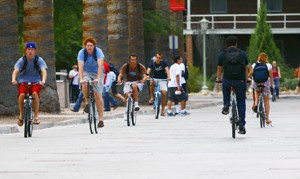Anyone who has biked to campus knows the perils of dodging pedestrians and cars alike. But anyone who has been struck by a car – an experience that has occurred to two 15-year-olds and a couple of UA students in the past few weeks – knows the serious concerns of bike safety in Tucson.
“”We are not treated as equals on the road,”” said Glen Broom, an evolutionary biology senior.
For Broom, an avid cyclist and former member of the university’s triathlon club, Tri-Cats, the dangers of riding a bicycle are all too familiar.
“”Just the other day, I was going down Broadway, and a car coming from the opposite direction turned left right in front of me,”” Broom said. “”He cut me off, and I had to swerve around him into traffic. It was terrifying.””
Officials say cyclists face a greater danger of injuries on busy streets off campus.
At least once every other day, the trauma center at University Medical Center handles a bicycle-related accident, said Dan Judkins, UMC trauma educator and injury epidemiologist.
The trauma center differs from the emergency room in that it typically deals with more serious injuries, while the ER is a less urgent center of care where patients usually check themselves in, he added.
In 2007, 201 bike crashes were brought to the trauma center, said Judkins.
“”In other words, there’s a lot of them,”” he said.
Bicycle accidents plague Tucson, especially since the city has cyclists nearly year-round due to its warm weather, Judkins said.
Last Friday, 15-year-old Kevin Robinson-Barajas died after he was struck by a school bus at East Fort Lowell Road and North Mountain Avenue, according to The
Associated Press.
Another 15-year-old, Eric Michael Sutton, suffered two life-threatening injuries Wednesday after he was struck by a minivan, the Arizona Daily Star reported.
Two UA students were struck by a vehicle last week and suffered minor injuries. Alan Cordero, a nutritional sciences senior, and Krystle Potter, a nutritional sciences junior, were hit on Sept. 9 as they rode through Mount Lemmon, Cordero said.
Cordero, who has been involved in two accidents, has no form of transportation other than his bike, he said. He must ride from his job at La Encantada to his home and to school several times per week.
“”Sometimes I do feel safe,”” Cordero said. “”Sometimes I don’t. It depends on when I’m riding and where I’m riding. Generally in the mornings I feel great. As I start heading back home, it gets kind of unsafe because of the traffic. As there’s more traffic and people are trying to get home and they’re tired, they’re really bad at driving.””
Cordero’s injuries were minor, he said. But other cyclists often suffer fractures to the legs, arms, face and ribs, or brain injuries, which are the worst and can result in death, Judkins said.
“”Even a minor brain injury can wipe out your college career,”” Judkins said. “”It is absolutely, inherently, extremely dangerous to ride a bicycle on a street in Tucson…What the hell is a painted line going to do to protect you when one of the two (a vehicle or cyclist) wanders over the painted line? It’s mythical protection.””
Trauma patients are ranked from one to four depending on the severity of their injuries. The first rank is moderate injuries, followed by serious, critical and very critical, or life-threatening injuries, Judkins added.
In 2007, there were 145 moderate injuries, 36 serious, 10 critical and 10 life-threatening, Judkins said. Out of these 201, 82 percent were male, because men tend to act more recklessly on two wheels.
Despite statistics on bicycle injuries, many students must ride their bikes for myriad reasons. These students rely on prudence and safety information to keep themselves out of danger.
“”There’s not a lot I can say on bicycle safety,”” said Billy Ludt, a natural resources senior. “”But one thing I’ve always been told is to keep an ID on me in case I get hit.””
Multiple research studies show that a bike helmet can help reduce brain injuries in bike accidents by 65 percent. For students who have no alternative to riding their bikes, Judkins advises, “”Pick your route carefully. Do not use a major arterial road. More than half the cyclists after dark do not have a light or a helmet. That’s insane. Please take some reasonable precautions.””
As the student body size increases, the number of cyclists is bound to increase with it, he said. Several roads leading into the university are more bike-friendly, notably University Boulevard and Mountain Avenue. Broom, Cordero and Judkins all advocate using these roads as opposed to Sixth Street, Campbell Avenue or Speedway Boulevard.









